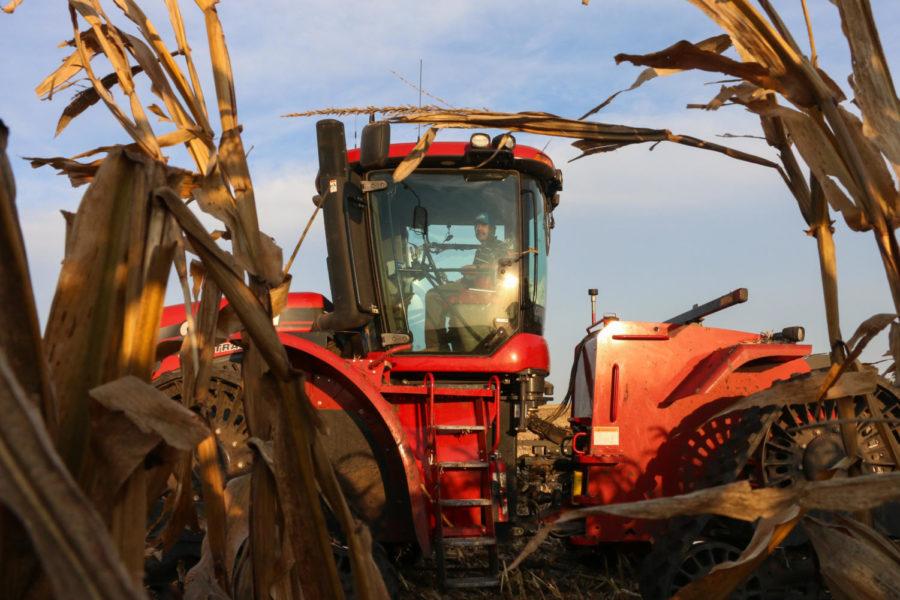Harvest: Moisture levels, higher yields, student perspectives
November 12, 2018
Due to increased moisture and rainfall amounts this year, crops were expected to be affected in various ways this harvest season, revolving mainly around grain quality.
The state saw about two weeks of rainfall on the front side of harvest, pushing back harvest and progress for farmers as well.
“From what I am hearing and looking at as well as the USDA crop report, soybean harvest is around 75 percent complete,” said Mark Licht, assistant professor and Extension Cropping Systems Specialist with Iowa State University Extension and Outreach. “Corn harvest is slower this year and is the slowest we have had, looking at right around 50% completion.”
Contrary to what was most predicted, moisture has not caused many issues with yield in both corn and soybeans.
“Soybeans are generally yielding 40 to 70 bushels per acre, 50 to 65 probably catches the majority; corn yields are seeing huge variation, I would say 190 to 230 bushels per acre is catching the majority,” Licht said.
This year, crops are actually yielding more, making moisture issues, such as the quality of the crop, have more of a negative impact on the markets for farmers.
“We are talking projected yields for both corn and soybeans,” said Chad Hart, associate professor of economics, Crop Markets Specialist and Extension Economist. “It’s a massive crop coming in and coming in late with quality issues, which is the biggest thing bothering the market right now.”
Those involved in the agriculture industry have stressed that this year’s moisture levels have caused various problems ranging from molds to rots.
“I think the rainfall is one of the large contributors of the poor quality of our grain this year,” Licht said. “The rainfall made poor stalk quality, ear drop, sprouting in both corn and soybeans. Because of the moisture and drying, we saw soybean pods shattering, which is largely moisture related.”
Issues, such as mold found in grain that farmers are trying to sell, cause reductions in price.
“We are getting beat down on price because it is a big crop, a low-quality crop, and because we are scrambling around trying to figure out what we are going to do with it,” Hart said.
With this year having such a big crop, how farmers store, market and sell their grain is going to be crucial. Crops with quality issues stored on the farm in bins needed to be watched carefully.
“Get it dried, get it cooled off as fast as you can, try to get it delivered off the farm by about March 1-15,” Licht said. “Don’t try to hold it much longer than that because the quality will decline quickly.”
Marketing is a way for farmers to capture future prices for a portion of the crops they will produce.
“Crop insurance is built to help farmers be more aggressive in looking at pre-harvest marketing opportunities,” Hart said.
Looking ahead for better prices is something farmers are far too familiar with.
“Grain prices are pretty low but they will likely improve,” Hart said. “What farmers are looking for storing the crop because they know commonly lowest prices occur now and they start to rebuild. Hopefully, by springtime better prices will be available/”
Farmers have found themselves in a unique situation this year due to the varying amounts of moisture across the state followed by a high yielding crop.
“You hate to have quality issues at the same time as you have a large quantity because those things reinforce the low price environment that we find ourselves in during this harvest,” Hart said.
Jack Hughes, a sophomore in agronomy, is from Woodstock, Illinois, and goes home to his family farm on the weekends to help with harvest.
“It’s interesting to see how crops turn out after you planted them in the spring,” Hughes said.
Hughes lives on his family farm that has been around since 1829. His farm is a little over 1,000 acres that harvests corn and soybeans.
“It’s been an okay year for harvest,” Hughes said. “We harvested our corn early compared to last year, and bean are touch and go because of rain and equipment breakdowns.”
When he was a kid, Hughes loved to ride with his dad and to help him out on the farm wherever and whenever he could. Now, he enjoys being able to run the big machinery that he once rode in with his dad.
Regan Pleggenkuhle, sophomore in agronomy, also goes back home to help his family with harvest. Located in West Union, Iowa, Pleggenkuhle’s farm is about 1,500 acres that harvest corn and soybeans.
“I usually go home about [every] weekend during October through November,” Pleggenkuhle said. “It just depends on what’s going on and what needs to be done.”
Harvest for Pleggenkuhle has been “so far, so good.” He and his family were able to get beans done, but they still have a few acres left of corn.
“It’s a good excuse to go home on weekends,” Pleggenkuhle said. “But, it’s fun to be home and reap the benefits from spring.”







